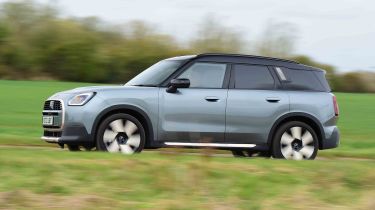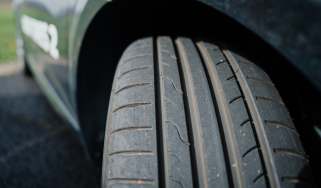MINI Countryman – MPG, emissions & running costs
Fuel economy aside, the running costs of the MINI Countryman are reasonable, while the EV has good range

Fuel economy for the petrol MINI Countryman, on-paper, is decent rather than class-leading, with the most efficient 1.5-litre getting 47.9mpg and emissions of 134g/km. The 2.0-litre ALL4 manages 39.7mpg and emits 149g/km because the additional weight of its four-wheel drive system hurts efficiency. The high-performance JCW model has the worst fuel economy and emissions of the Countryman range, with 35.3mpg and 180g/km of CO2.
From Exclusive trim and above, you can increase the fuel tank size with each ‘Level’ pack by nine litres to 54 litres, giving you a little bit longer between trips to the pumps.
|
Model |
MPG |
CO2 |
Insurance group |
|
Countryman 1.5 C Classic |
47.9mpg |
134g/km |
20E |
|
Countryman 2.0 ALL4 S Classic |
39.7mpg |
149g/km |
25E |
|
Countryman 2.0 ALL4 JCW |
35.3mpg |
180g/km |
30E |
Electric range, battery life and charge time
The MINI Countryman has gone all-electric now, an upgrade on the previous model that only had a plug-in hybrid option. That means a much larger 66.45kWh (63.78kWh useable) battery pack that can offer up to 285 miles of range for a two-wheel drive Classic model, or 266 miles for a more potent four-wheel drive version, which is competitive with the BMW iX1.
Using a 7.4kW home wallbox charger, it’ll take around 10 hours to fully recharge a Countryman, while a 10-80 per cent top up from a rapid charger will take around 30 minutes. A 130kW maximum charging speed is again competitive, but there are similarly priced EVs out there like the Hyundai Ioniq 5 that’ll charge much faster.
Tax
The electric MINI Countryman will be the most appealing to company car drivers because these versions will sit in a much lower Benefit-in-Kind (BiK) tax bracket than the petrol model. The most efficient 1.5 petrol is in the 31 per cent bracket, rising to 34 per cent for the 2.0-litre four-wheel drive model. The JCW sits in the highest 37 per cent tax bracket.
More reviews
Car group tests
In-depth reviews
Long-term tests
Road tests
The electric Countryman will be free of road tax (VED) because it has zero tailpipe emissions and can be driven into the London Congestion Charge zone for nothing, although that will change in 2025.
Most versions of the petrol MINI Countryman cost less than £40,000 when new and avoid the luxury car surcharge applied to expensive cars. Just be careful with the options list, because some pricey packs can send the price way over this limit.
Insurance groups
Insurance costs for the MINI Countryman should be reasonable considering they start in group 20 for the entry-level 1.5 Classic, and rise to group 30 for the quickest JCW model. Even the electric version is comparable with the regular petrol version, starting in group 23 for the least powerful E model, and ending in group 31 for the quicker SE four-wheel drive. That’s a few groups lower than the BMW iX1.
Depreciation
According to our expert data, the MINI Countryman maintains a decent amount of its resale value after three years or 36,000 miles, whether you go for a petrol or electric version.
The petrol maintains between 49 and 53 per cent of its value after three years, with the worst model being the 2.0-litre ALL4 Exclusive (Level 3), and the best being the least expensive 1.5 Classic. The electric model does even better, with the two-wheel drive E in Exclusive trim retaining 51 per cent, and the four-wheel drive SE Classic hanging on to 54 per cent.
To get an accurate valuation of a specific model, check out our valuation tool




